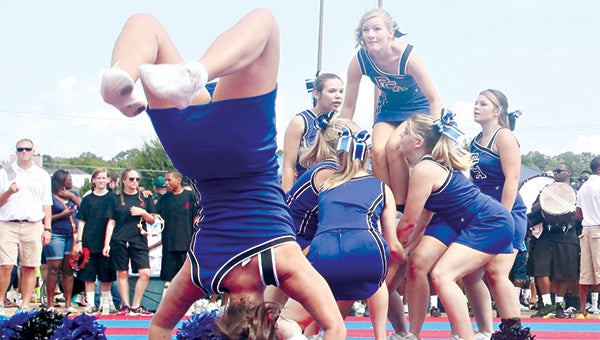Doctors push cheerleading as a sport
Published 11:40 am Friday, June 20, 2014

Porters Chapel Academy cheerleaders perform during last year’s annual citywide pep rally at the Outlets at Vicksburg.
Fresh off a lobbying victory for the “Return to Play” law to prevent concussions in prep sports, the Mississippi State Medical Association wants to see cheerleading get the same protection in high school sports despite procedural hurdles.
A group of 22 Mississippi physicians who attended a meeting of the American Medical Association in Chicago last week leant their names to an effort to ask accrediting bodies to declare cheering a sport to improve safety procedures, according to a release from MSMA. The initiative includes avoiding inappropriate surfaces and creating guidelines when doing flips and other stunts.
“Cheerleading is as rigorous as many other sporting activities considered by high schools and the NCAA as sporting activities,” said Dr. Lee Voulters, a Gulfport neurologist who chairs the MSMA board of trustees. “Cheerleaders are not exempt from the same type of injuries occurring in other sports. I’ve had young ladies come in after a fall and I find they have suffered a concussion. Then, they are told by their coaches to get right back out there. I am very concerned about what is happening in our schools and want cheerleaders to have the same protection as athletes involved in contact sports.”
The state’s delegation to the AMA meeting included Drs. Randy Easterling, Geri Weiland and Lee Giffin. Another Vicksburg physician, Dr. Daniel P. Edney, is vice-chair of the MSMA board.
Effective July 1, if a student-athlete in Mississippi public and private schools is suspected of having a head injury while playing a school-sponsored athletic event, that student is removed from play and is barred from returning until they are examined by a trained professional and cleared to return. The protocol is also in effect for non-members of the Mississippi High School Athletic Association or the Mississippi Association of Independent Schools for grades 7 through 12. The law also protects schools and health care providers from lawsuits if the provisions of the law, which was House Bill 48, are followed.
Putting a flyer or spotter on the cheerleading team in the same category as a quarterback or linebacker for the purposes of enhancing the new law would require another act of the Legislature. No initiative to consider cheerleading a sport has come before the MHSAA executive committee since Gov. Phil Bryant signed the bill in January.
Past and present cheer coaches contend the heightened awareness about concussions, mainly from the NFL, which also pushed for the law, is a good thing. Implementation of new standards in the world of acrobatics and pom-poms might require a new designation.
“MHSAA considers us sponsors and not coaches, so I’m anxious to see what they’ll do,” said Jennifer Grey, cheer coach at Vicksburg High School.
The public school sports governing body “would welcome conversation” on the topic, but the idea is far from a done deal, MHSAA executive director Don Hinton said. One difference between cheerleading and, for example, football, is that most team sports have specific seasons and cheering does not. Another is that cheerleading has two distinct components — sideline and competitive — that makes it different from popular team sports.
“The NCAA does not consider cheerleading a sport,” Hinton said. “But, we would want to work together (with doctors’ groups) on the issue.”
Injuries through the years haven’t been as serious as in higher-profile team sports, Grey said.
“The worst I’ve had is ankles,” Grey said. “They’ll come down and sprain it. With cheerleading, there’s a certain way you’re supposed to fall. And we teach it how you’re supposed to fall and how you’re supposed to catch. If you do that, you’ll be safe.”
VHS retains an athletic trainer who works with cheerleaders when injuries happen, Grey said.
“Parents know what it’s all about,” Grey said. “I send home all the release forms, with all kinds of information about water breaks for summer practices. We do whatever the trainer tells us to do.”
Clara Grantham, who coached cheerleaders at Warren Central High School for 18 years until retiring in 2010, favors the new law in light of more athletically demanding routines and more competitions on television since her own career started.
“Those are good for the ones doing competitive cheerleading,” Grantham said. “We had to follow the same rules the other sports did.”
Grantham said the worst injury during her time guiding the Viking cheerleaders didn’t occur during a routine. And, as is the case now, her teams stayed mostly female despite a growing presence of male cheerleaders in other places.
“Probably the worst injury happened when a girl tore an ACL while dancing to the band on Friday night,” Grantham said. “A few were checked out at the ER, but we didn’t have any head injuries.”
“I had but two guy cheerleaders, in my next to last year there. They didn’t do any more throwing than the girls did. I think the girls are doing more now, with the basket tosses when they throw them in the air. I think in the last they are just more aware of concussions now.”





